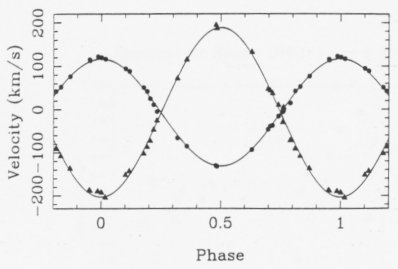
 |
"Velocity curves" for the spectroscopic binary Pi Scorpii (derived from spectral Doppler shifts) show the back-and-forth velocities of each of the two components. The more massive class B1 star has the smaller variation, the less massive B2 star the greater, in inverse proportion to the mass ratio. Since the orbital tilt is (without additional information) unknown, the observed velocities are lower limits to the true velocities, and give lower limits to the orbital sizes and stellar masses. The symmetrical "sine waves" traced out by the stellar velocities reveal circular orbits. (From an article by D. J. Stickland, C. Lloyd, R. H. Koch, and I. Pachoulakis in the The Observatory.) |